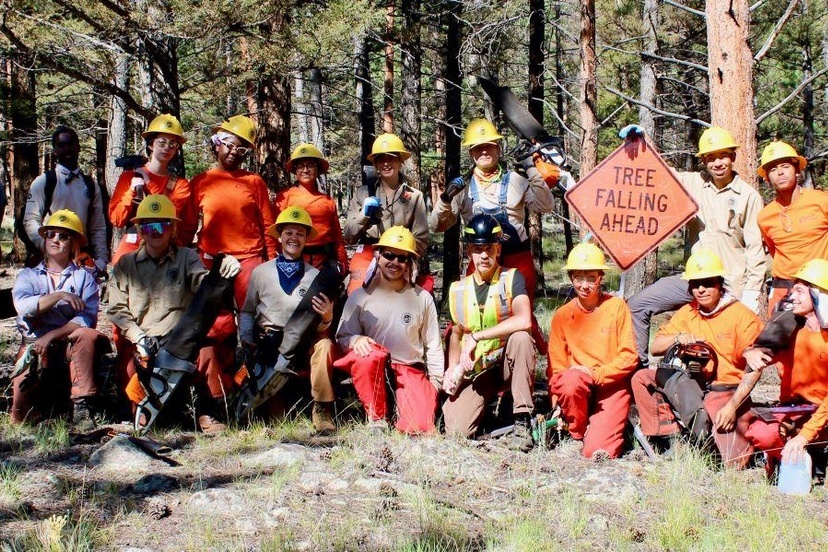By Chris Arend
Colorado Governor Jared Polis joined with state officials from the Colorado Department of Natural Resources and Colorado State Forest Service to celebrate the extension of an important agreement with the U.S. Forest Service on Shared Stewardship of lands in Colorado and highlight the progress made to reduce the impact of wildland fires in highly susceptible communities and on critical infrastructure.
In the last decade, Colorado has seen its largest and most damaging wildland fires in its history. The increase of these wildfires and impacts on communities and Colorado landscapes was a call to action for state, federal, and local land managers to work collaboratively, under Shared Stewardship principles on a landscape level to focus investments in forest treatments and mitigation measures in strategic areas which would have the most on the ground impact.
“The wildfires we’ve seen in Colorado over the past decade have dramatically changed our landscapes, impacting our communities, water resources and recreation opportunities,” said Regional Forester Troy Heithecker of the USDA Forest Service’s Rocky Mountain Region. “It’s critical we continue to work together and across boundaries with our partners and communities. This is the only way we’ll create and maintain resilient forest ecosystems that help protect communities, provide healthy functioning watersheds, quality wildlife habitat, and maintain sustainable outdoor recreation opportunities for future generations.”
In 2018, the U.S, Department of Agriculture Forest Service released its national Shared Stewardship strategy outlining three core elements: Determine management needs on a state level, do the right work in the right places at the right scale, use all available tools for active management. In a Shared Stewardship approach, the USDA Forest Service seeks to share decision space with state and Tribal foresters and other partners to determine land management needs at the state and Tribal level.
The Department of Natural Resources and U.S. Forest Service signed a Memorandum of Understanding in 2019 to work together in Shared Stewardship. In May 2024, the U.S. Forest Service and Colorado Department of Natural Resources extended the agreement for an additional 10 years.
The Colorado State Forest Service is also a key partner in the state’s Shared Stewardship efforts, collaboratively deploying its Forest Restoration & Wildfire Risk Mitigation (FRWRM) Grant Program, Wildfire Mitigation Incentives for Local Government Grant Program, Wildfire Risk Mitigation Loan Fund and other programs funded through Healthy Forests and Vibrant Communities, as well as numerous partnerships and agreements with local, state and federal partners, to implement forest health and fuels reduction projects. The Colorado State Forest Service also has regional offices and foresters who work directly with partners and private landowners to offer technical assistance focused on fuels mitigation and educational programs that help individuals and communities implement Firewise practices and develop and implement Community Wildfire Protection Plans.
“Shared stewardship is how we do the business of managing Colorado’s forests. Working together through shared priority setting, across boundaries, at the scale and intensity of the challenges we face is how we’ll conserve our Colorado way of life that is so deeply tied to our natural heritage, but is also under threat from a wildfire crisis. This extension of Colorado’s Shared Stewardship agreement with the USDA Forest Service signals a doubling down on the notion that we’re in this fight together. We have accomplished a fair amount through our partnership, but it is time to take our shared work to the next level to ensure Colorado’s forests and communities are resilient in the era of megafire,” said Matt McCombs, Director, Colorado State Forest Service.
On a local level, shared stewardship has not only assisted local communities with ongoing projects but sparked local governments to create their own investments and programs to either match funding or build upon needed local projects to further empower on the ground work.
As part of the shared stewardship event, Director Gibbs also announced the state’s investment of $10 million for its Landscape Resilience Investment Program within DNR’s Colorado Strategic Wildfire Action Program (COSWAP). The Landscape Resilience Investment Program invests funding in targeted mitigation projects in COSWAP’s strategic focus areas. The projects selected for funding are collaboratively developed to meet the greatest needs of the area.
This year 11 projects were awarded between $500,000 and $1,100,000 and were matched by $6,100,000.
COSWAP was launched by the Polis administration through the bipartisan SB21-258, which invested in targeted wildfire risk mitigation, and prioritized and funded key mitigation projects. COSWAP’s initial success led it to become a permanent program and it continues to support fuel reduction projects, critical forest restoration and wildfire mitigation work that will increase community resilience and protect life, property and infrastructure.
In addition to making forest mitigation a priority, Colorado also has invested significantly in watershed protection- a key component of forest restoration. Approximately 80 percent of Colorado’s population relies on forested watersheds to deliver water supplies. The Colorado Water Conservation Board’s Wildfire Ready Watersheds Program (WRWP) has invested $6.6 million in planning and projects to better equip Colorado’s communities, streams and water supplies to resist the detrimental impacts of catastrophic wildfire with another $2.9 million to be allocated by the end of the year. In 2024, COSWAP staff worked with the WRWP to identify key areas in the state to leverage each other’s programs. Almost $2 million has been awarded to 2 landscape projects, in the Yampa Valley near Steamboat Springs and Jefferson Conservation District in Jefferson County that are currently completing a Wildfire Ready Watershed’s Action Plan. There are plans to expand and build upon this collaboration in the coming years.
In addition to state investments, since 2020, the U.S. Department of Agriculture also announced significant federal investments in forest management in Colorado. The U.S. Forest Service 10-Year Wildfire Crisis Strategy directs $18.1 million in Bipartisan Infrastructure Law investments to Colorado National Forests in 2022, and $170.4 million over 2022-2024.
Several Colorado projects also secured $6 million through the Collaborative Forest Landscape Restoration Program (CFLRP).
Chris Arend is Communications Director with the Colorado Department of Natural Resources.

